MONDAY, JANUARY 23, 2023. BY STAN GRANT, VITICULTURIST.
A vineyard floor is an interface between the atmosphere above and the soil below, which affects both. Vineyard floor effects gradually change over the course of a growing season in concert with changes in the adjacent environments. Specific effects depend on vineyard floor attributes, including surface soil density and structure, surface roughness, and the presence or absence of vegetation (Figure 1). Tillage is a principal means by which vineyard managers affect these attributes.
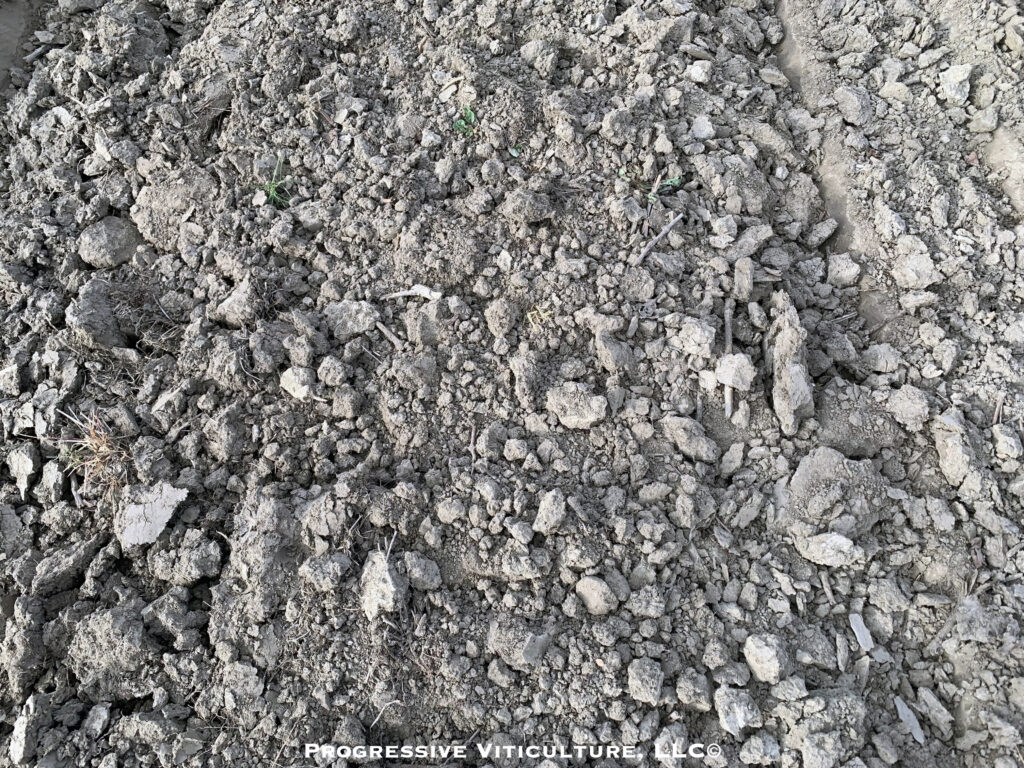
Figure 1. Vineyard floor roughness and absence of vegetation are among the attributes affecting the adjacent atmosphere above and soil below. (Photo Source: Progressive Viticulture, LLC©)
Tillage is the mechanical manipulation of a soil profile with the aim of improving root zone conditions. It is among the oldest agricultural practices. In viticulture, the term tillage usually refers only to mechanical manipulation of the surface soil. Such tillage is shallower than about 18 inches below the soil surface. For more information about deep tillage, click HERE.
While tillage under the vines in the row is possible, only the open areas between vine rows, the tractor rows, are tilled in most vineyards. Accordingly, tractor-row tillage is the focus of this article.
The When, Why, and How of Tractor Row Tillage
Early in the growing season, tractor row tillage simultaneously terminates vegetation (a volunteer or planted cover crop) and mixes it into the soil (Figure 2). In so doing, tillage ends the ground cover’s consumption of water and mineral nutrients, disrupts surface crusts, adds organic matter to the topsoil, and creates a layer of loose, low-density soil that acts as a barrier to soil moisture loss to the atmosphere through evaporation. Especially when tillage occurs while a ground cover is green and succulent, populations of soil microbes are stimulated, nutrient cycling and retention are extended, and soil tilth, fertility, and water-holding capacity are enhanced, at least temporarily. As such, tillage is primarily a root zone resource management activity.
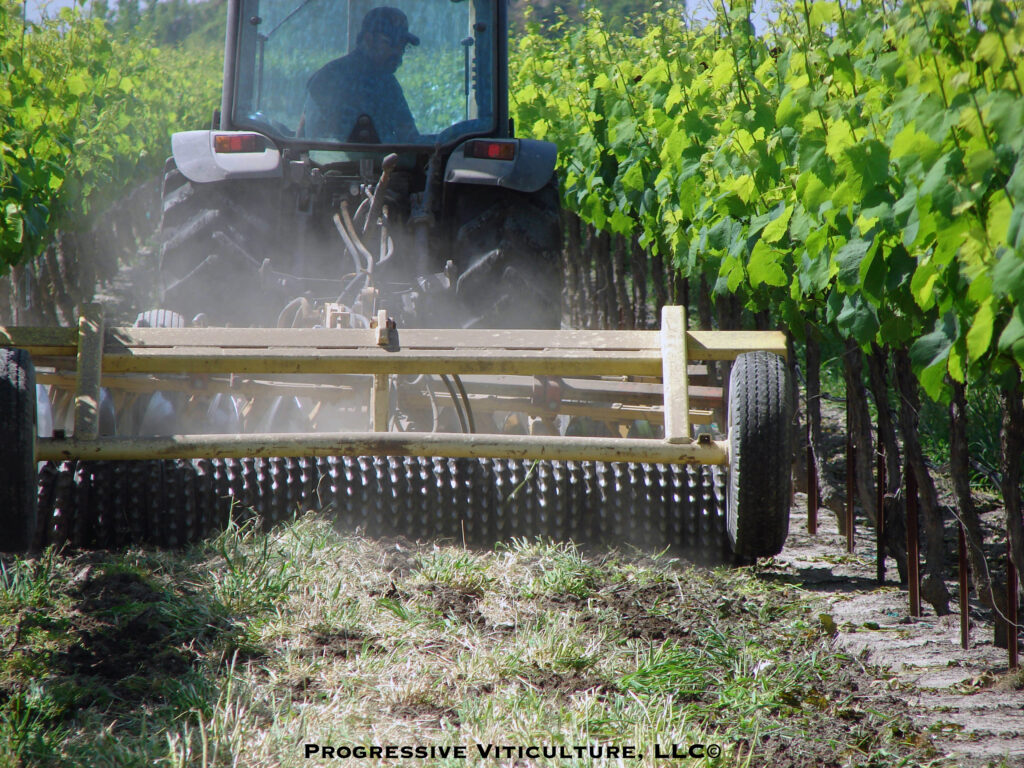
Figure 2. Tillage simultaneously terminates a cover crop and incorporates it into the underlying soil. (Photo Source: Progressive Viticulture, LLC©)
Due to its effects, tillage remains a key management activity for most dry-farmed vineyards in California, as well as vineyards prone to low growth vigor. Topsoil tillage is also a prerequisite for making furrows in surface irrigated vineyards and a technique for mitigating cracking in clay soils. For all vineyards, surface soil tillage is an option for providing a few degrees of passive frost protection by enhancing the transfer of heat absorbed in the soil during the day to the atmosphere at night. Such heat exchange works best when tilled soils are firm and moist.
Late in the growing season, tillage is the method for blending amendments and fertilizer into topsoil. Such incorporation of applied materials is another way in which tillage influences root zone resources. It can also prepare a seedbed for a cover crop.
Tillage is commonly a two-step process. Primary tillage breaks up the soil into clods of varying sizes and secondary tillage pulverizes, repacks, and smooths the soil. Certain combinations of tillage equipment and multitask cultivators can complete both steps in a single pass, especially on sandy soils. Adjust the depth of successive tillage passes or alternate the type of cultivator to limit smearing at the bottom of the tilled soil, which can create high-density layers or pans that restrict soil permeability and drainage.
Enter No-Till
As with so many aspects of winegrape growing, drip irrigation created new possibilities for the management of tractor rows. Freed from the need for tillage to conserve stored soil moisture or facilitate surface irrigation, vineyard managers have an opportunity to pursue no-till or minimum tillage strategies. Drip irrigation also made possible vineyard development on rocky soils unsuited for tillage.
Under no-till, cover crops remain, with the possible exception of mowing, undisturbed through the growing season (Figure 3). This vegetation, whether alive, dead, or mowed stubble mulch, protects the soil surface from erosive forces and hinders crust formation. At the same time, below ground the roots of cover crops bind soil particles together, thereby increasing surface soil porosity and its resistance to compressive and erosive forces. The cumulative effects of no-till typically include increased soil permeability to air, water, and elongating roots, and reduced compaction, erosion, and dust. As such, the advantages of non-tillage are mainly environmental.
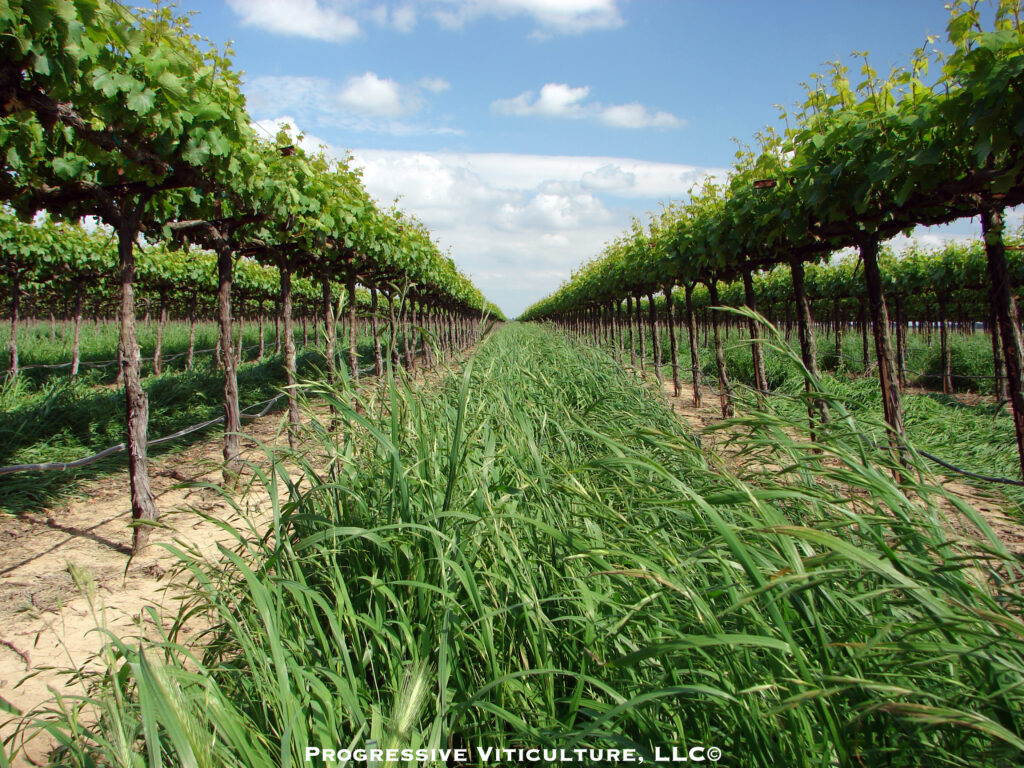
Figure 3. A forage grass cover crop in a no-till Chardonnay vineyard.(Photo Source: Progressive Viticulture, LLC©)
By increasing the capacity for water infiltration, a non-tilled vineyard floor can hasten labor and equipment access after rains. Robust cover crops that persist through the early growing season can devigorate overly vigorous vines through competition for soil resources. Live vegetation in the tractor row reflects certain bands of incoming solar radiation, with an influence on grapevines that depends on factors such as climate, time of year, slope, aspect, the portion of tractor row exposed, and vineyard design.
Mowed cover crop residues, when sufficiently thick, act as mulches, which constrain evaporative moisture loss from tractor row soils. Mowing can also reduce the risk of vine frost damage and competition with vines for soil resources, but with the side effects of stunted cover crop biomass and reduced environmental benefits.
In practice, total non-tillage seldom happens because over time cover crops decline, surface crusts form and vineyard floors become rutted. In addition to eliminating deteriorating cover crops, disrupting crusts, and removing ruts, periodic tillage redistributes organic matter and mineral nutrients, placing them deeper into the root zone and making them less susceptible to loss to the environment. For these reasons, most no-till vineyards are, in fact, infrequent-till vineyards, a practice some have recently named strategic tillage.
Till or No-Till?
Clearly, developing a vineyard floor management plan is a complex task requiring a systematic approach. Begin with consideration of the primary management challenges and goals for the vineyard. For vineyards that are dry-farmed, prone to frost damage, susceptible to erosion, or with too little or too much vine growth vigor, the decision to till or not to till may be obvious.
More often, a vineyard manager has more than one objective for his or her vineyard floors. In these cases, the best selection may not be solely tillage or non-tillage, but some combination of the two.
One approach is to till in part of the vineyard and not till in the other. For example, a portion of a vineyard prone to frosts is tilled, while another portion that is prone to erosion is not. This vineyard floor management technique may be appropriate for vineyards where sloped, erosion-prone hillsides coexist with frost-prone valleys.
On flatter terrains, a common practice is alternate tractor row tillage and non-tillage (Figure 4). With this method, the non-tilled tractor row is available for vineyard operations with minimum soil compaction and dust, and with rapid access after rain. In other words, the environmental benefits are available in this tractor row. In the adjacent tractor rows, organic plant matter is incorporated into the soil and soil water is conserved. In these rows, root zone resources are enhanced.
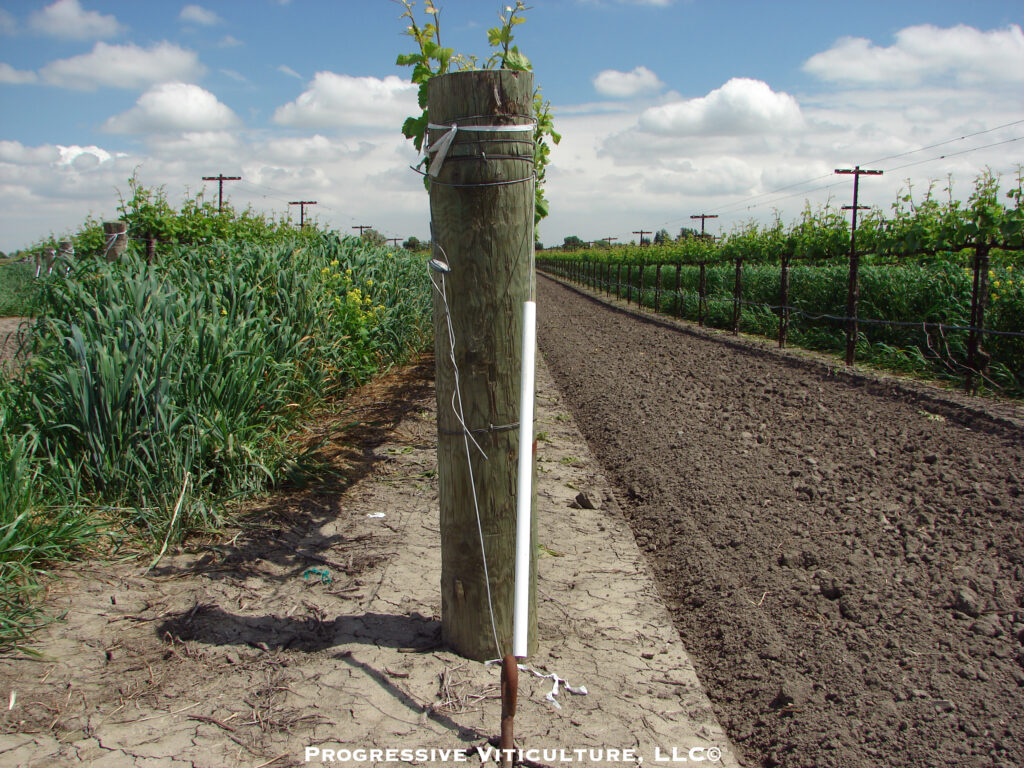
Figure 4. Alternating tilled and non-tilled tractor rows in a Pinot noir vineyard. (Photo Source: Progressive Viticulture, LLC©)
Periodic switching of tilled and non-tilled tractor rows minimizes pan formation, crust, and rut development, and cover crop decline, thereby enhancing the benefits of both tillage and non-tillage. Further, periodic tractor row switching affords an opportunity to change cover crop species, which like rotating tomatoes with another annual crop species, helps to control soil-borne pests and diseases.
Optimizing Till and No-Till
Various tillage implements are available for vineyards, including harrows, rigid tine and spring tine cultivators with chisels, shovels, and sweeps; disks; and power-driven cultivators (Figure 5). According to conditions, utilize the one that, at an appropriate speed, sufficiently incorporates plant materials with minimum disturbance of soil structure (aggregation). Also, for the same reasons, till no deeper and make no more passes than necessary, mindful that some visible ground cover remnants are tolerable. Again, vary the depth of tillage as needed to avoid pan development.
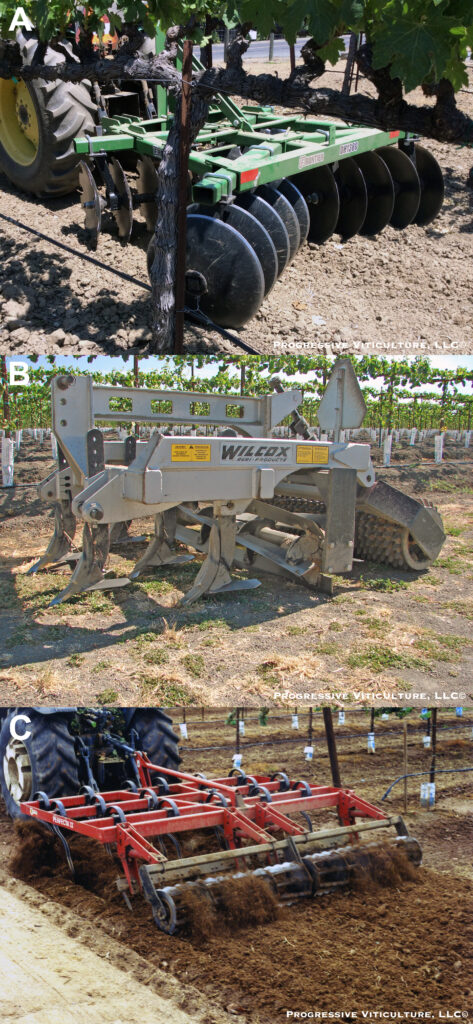
Figure 5. Examples of vineyard tillage equipment include a tandem disk (A), a combination rigid tine cultivator with sweeps, crumbler, and ring roller (B), and a spring tine cultivator with roller preparing a seedbed for a cover crop (C). (Photo Source: Progressive Viticulture, LLC©)
Selecting the proper implement, tilling early, tilling no deeper than necessary, and minimizing the number of passes will also contain the financial costs of tillage. At all times, avoid working the soil while it is wet to minimize compaction and avoid tillage under windy conditions to minimize soil loss to erosion.
To sustain a healthy ground cover and a permeable soil surface in a non-tilled vineyard, consider techniques such as amending, fertilization, aeration, shallow chiseling, and overseeding. A few vineyard operations practice extended no-till, using special no-till drills to plant (overseed) a new cover crop through the residues of the previous cover crop.
Forage and turf grasses tolerate mowing, but cereal grains and some legumes do not regrow after shoot tips are removed. Mow grass covers crops no shorter than about 4 inches tall to encourage regrowth. In general, rotary mowers make cleaner cuts, but flail mowers better handle bulky cover crop biomass. If feasible, limit the number of mowings, which can diminish the environmental benefits of tractor row no-till.
Conclusions
Management goals and challenges are the basis for decisions to till or not to till a vineyard. These decisions include both soil resource and vineyard environment considerations (Table 1). In some instances, the best solution is a combination of till and no-till. Both practices require careful execution to produce the greatest benefit for a vineyard.
A version of this article was originally published in the Mid Valley Agricultural Services April 2012 newsletter and was updated for this blog post.
Further Reading
Creasy, GL, and Creasy, LL. Grapes. (Crop production science in horticulture series, 16.) CABI, Wallingford, Oxfordshire, UK. 2009.
Dregne, HE, and Willis, WO (Eds.). Dryland agriculture. American Society of Agronomy, Madison, Wisconsin. 1983.
Follet, RF, and Stewart, BA (Eds.). Soil erosion and crop productivity. American Society of Agronomy, Madison, Wisconsin. 1985.
Follett, RF, Steward, JWB, Cole, CV, and Power, JF (Eds.). Soil fertility and organic matter as critical components of production systems. Soil Science Society of America Special Publication Number 19. Soil Science Society of America, Madison, WI. 1987
Grant, J, Kelly-Anderson, K, Prichard, T, Hasey, J, Bugg, RL, Thomas, F, and Johnson, T. Cover crops for walnut orchards. University of California Agriculture and Natural Resources Publication 21627. 2006.
Grant, S. Considerations for dry farmed vineyards. Lodi Winegrape Commission Coffee Shop. (www.lodigrowers.com). January 26, 2015.
Grant, S. Maximizing cover crop benefits through selection and management. Lodi Winegrape Commission Coffee Shop. (www.lodigrowers.com). October 12, 2015.
Grant, S. Frost management strategies for vineyards. Lodi Winegrape Commission Coffee Shop. (www.lodigrowers.com). April 3, 2017.
Grant, S. Using competition to best advantage in vineyard management. Lodi Winegrape Commission Coffee Shop. (www.lodigrowers.com). June 8, 2020.
Grant, S. There is more to vineyard floors. Lodi Winegrape Commission Coffee Shop. (www.lodigrowers.com). March 28, 2022.
Grant, S. Soil compaction: a stealthy thief. Lodi Winegrape Commission Coffee Shop. (www.lodigrowers.com). September 19, 2022.
Guerra, B; Steenwerth, K. Influence of floor management technique on grapevine growth, disease pressure, and juice and wine composition: a review. American Journal of Enology and Viticulture. 63, 149-164. 2012.
Hillel, D. Introduction to soil physics. Academic Press, New York. 1982.
Ingels, CA, Bugg, RL, McGourty, GT, and Christensen, LP (Eds.). Cover cropping in vineyards. University of California Division of Agriculture and Natural Resources Publication 3338. 1998.
Kaspar, TC, and Singer, JW. The use of cover crops to manage soil. In Soil management: building a stable base for agriculture. Hatfield, JL, and Sauer, TJ (Eds.). Agronomy Society of America and Soil Science Society of America, Madison, Wisconsin. 2011.
Klonsky, K, and Elmore, C. Almond orchard floor management costs. pp. 25-26. California Agriculture. July-August, 1989.
McCarthy, MG, Dry, PR, Hayes, PF, and Davidson, DM. Soil management and frost control. pp. 148-177. In Viticulture: Volume 2 Practices. Coombe, B, and Dry, PR (ed.). Winetitles, Adelaide. 1992.
Morlat, R, and Jacquet, A. Grapevine root system and soil characteristics in a vineyard maintained long-term with and without interrow sward. American Journal of Enology and Viticulture. 54, 1-7. 2003.
Nicholas, P. Soil, irrigation, and nutrition. South Australia Research and Development Institute. 2004.
Oster, JD, Singer, MJ, Fulton, A, Richardson, W, and Prichard, T. Water penetration problems in California soils. University of California Division of Agricultural Sciences Kearney Foundation for Soil Science. Undated.
Reeder, R. Conservation tillage systems and management. 2nd Ed. Midwest Plan Service (MWPS), Iowa State University, Ames. 2000.
Rendig, VV, and Taylor, HM. Principles of soil-plant interrelationships. McGraw-Hill, New York,1989.
Sever, M. Strategic tillage has its place in no-till agriculture. Crops and Soil Magazine. November-December, 2021.
Snyder, RL, Paw U, KT, and Thompson, JF. Passive frost protection of trees and vines. Cooperative Extension, University of California Division of Agriculture and Natural Resources Leaflet 21429. Undated.
van Huyssteen L. Grapevine root growth in response to tillage and root pruning practices. pp. 44-56. In The Grapevine Root and Its Environment. JL Van Zyl (ed.). Department of Agriculture and Water Supply, Pretoria, South Africa. 1988.
Winkler, AJ, Cook, JA, Kliewer, WM, and Lider, LA. General viticulture. University of California, Berkeley. 1974.
Have something interesting to say? Consider writing a guest blog article!
To subscribe to the Coffee Shop Blog, send an email to stephanie@lodiwine.com with the subject “blog subscribe.”
To join the Lodi Growers email list, send an email to stephanie@lodiwine.com with the subject “grower email subscribe.”
To receive Lodi Grower news and event promotions by mail, send your contact information to stephanie@lodiwine.com or call 209.367.4727.
For more information on the wines of Lodi, visit the Lodi Winegrape Commission’s consumer website, lodiwine.com.
For more information on the LODI RULES Sustainable Winegrowing Program, visit lodigrowers.com/standards or lodirules.org.



